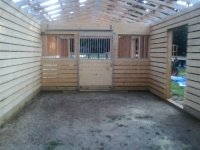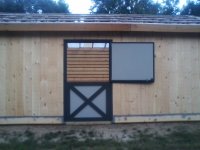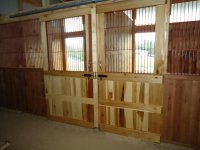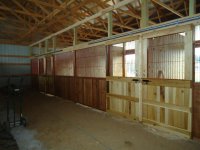Dadnatron
Veteran Member
We are building a barn, and a large portion of the cost is the stalls. And on this barn, I'm looking at 14 stalls.
I've done some looking, and they are all over the map from relatively inexpensive but certainly functional wood to high end metal. We are more on the Metal side of the spectrum.
I am looking to put in 2 panels and a sliding door. Total dimensions of the front will be 14' with a centered 4' door on tracks. I like airflow and visual access to my horses, and most of the barns we have been seeing have been a variant on what I have pictured below. It just seems that they are VERY EXPENSIVE for what I am getting. I'm not a welding expert by the least sense of the word (I aspire to be a novice) but after getting quotes from $3500 to $6000 per stall front, I began thinking that perhaps this is a job which I could take on myself. I've looked at many MANY doors and fronts, and when I think about it, they just don't appear to be that involved. That could certainly be the novice in me talking, which is why I am here asking you.
Each panel would be about 5' wide. The panel structure would be 2x3" rectangular tubing around the periphery 2x6" center cross member. The mesh is 5/16" bar on 2" squares, welded at each crossing. It is welded to the inside center of the frame, not just stuck to one side or the other and welded, so the fit obviously has to be perfect. The door would be basically the same but only 4' wide. There would be a roller/slide along the top to move the door.
I know there would be material costs. I know there would be paint costs. But I just have a hard time believing they would approach $5-6K per stall front. I was thinking I could use the difference and invest in a big welding table and build a jig. Buy a good coldcut saw, etc etc etc and by the time I was through, I would have some really nice equipment and a much better welding skill, and still come out $$$ ahead. But... I don't know, hence I am here.
This might be far more than I can handle, and I am just testing the waters at this point. But, I'd like your thoughts.
Basically like this:
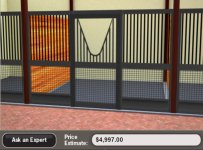
I've done some looking, and they are all over the map from relatively inexpensive but certainly functional wood to high end metal. We are more on the Metal side of the spectrum.
I am looking to put in 2 panels and a sliding door. Total dimensions of the front will be 14' with a centered 4' door on tracks. I like airflow and visual access to my horses, and most of the barns we have been seeing have been a variant on what I have pictured below. It just seems that they are VERY EXPENSIVE for what I am getting. I'm not a welding expert by the least sense of the word (I aspire to be a novice) but after getting quotes from $3500 to $6000 per stall front, I began thinking that perhaps this is a job which I could take on myself. I've looked at many MANY doors and fronts, and when I think about it, they just don't appear to be that involved. That could certainly be the novice in me talking, which is why I am here asking you.
Each panel would be about 5' wide. The panel structure would be 2x3" rectangular tubing around the periphery 2x6" center cross member. The mesh is 5/16" bar on 2" squares, welded at each crossing. It is welded to the inside center of the frame, not just stuck to one side or the other and welded, so the fit obviously has to be perfect. The door would be basically the same but only 4' wide. There would be a roller/slide along the top to move the door.
I know there would be material costs. I know there would be paint costs. But I just have a hard time believing they would approach $5-6K per stall front. I was thinking I could use the difference and invest in a big welding table and build a jig. Buy a good coldcut saw, etc etc etc and by the time I was through, I would have some really nice equipment and a much better welding skill, and still come out $$$ ahead. But... I don't know, hence I am here.
This might be far more than I can handle, and I am just testing the waters at this point. But, I'd like your thoughts.
Basically like this:

